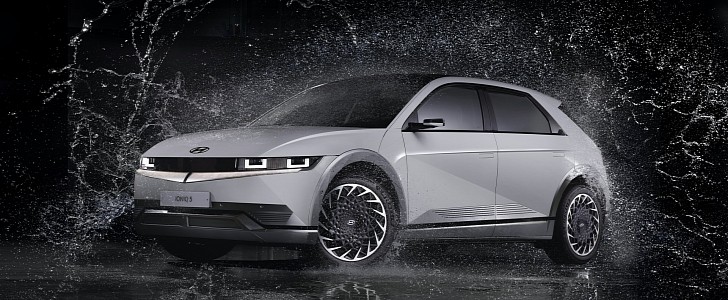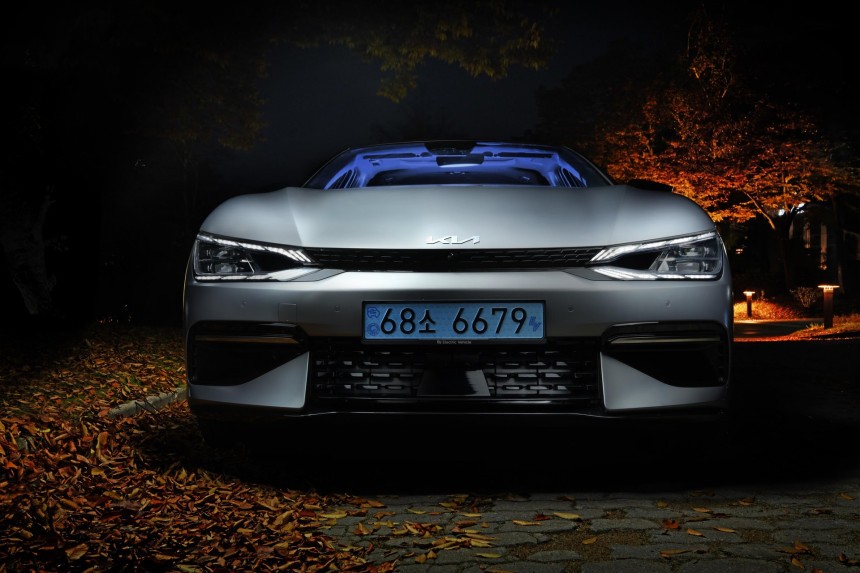What’s it going to be: a diesel or a gas engine? The choices are limitless. Hyundai and Kia are trying their best when it comes to manufacturing EVs. The Ioniq 5 and the EVs prove it. But it seems like both companies want to take it a bit further – not with new motors or batteries, but with engine sound. But not any kind of sound played through the speakers, no. It’s a vibration the companies already patented!
Would you like to wake up in the morning, start brewing some coffee, and turn on your sensible EV that can sound like a crazy V8 or V12 just to let it settle before driving off? If you thought this was a joke or an unfeasible proposal, think again. The Koreans are trying to bring you this experience that’s no more at the patent-pending level, since the United States Patent and Trademark Office (USPTO) has already granted it to Hyundai and Kia. But how will your future Ioniq 5 N or Kia EV6 GT sound like a V8 or V12 or even a snazzy in-line 5-cylinder if both companies never really focused on selling such big engines? Or is it possible that we're in the wrong with these assumptions, and both automakers are planning on making your future EV sound like it has a 1.6-liter T-GDi under the hood? Here's what we know.
According to a recently disclosed USPTO filing that you can find attached down below, Hyundai and Kia are planning on implementing a way for their EVs to simulate the existence of an internal combustion engine (ICE) under the hood. It’s not through speakers alone. That would ruin your listening experience. The carmakers are looking to introduce a virtual vibration effect that’s based on speed and torque. It’s not just the acceleration that you’ll hear, but you’ll feel the engine working as even the torque will be felt by the driver and passengers.
While Porsche and BMW are trying their best to make their EVs sound like spaceships and Rivian actively trying to not hide how their motors really sound, Hyundai and Kia will provide future owners with the option to make their EV sound and feel like it has a thermal engine under the hood. The explosive power will live on even after the phase-out of ICEs.
The Koreans are planning on using a system that can constantly analyze how the car is behaving to provide the artificial sensation of a real engine. As the document shows, they want to collect relevant information regarding speed, acceleration, and braking. Using these data sets, they’ll then determine how the cabin feeling should be adjusted to mimic the sensation of an ICE. Everything is dynamic.
This will be achieved through a separate driving small motor that is connected to the driving wheels and has a preset installed that can personalize itself as it gets used by the owner. Even the multi-stage transmission feeling is considered, as well as idling. This will be part of a system that'll analyze everything relevant in real-time and aims to provide the same feeling by filtering important data sets previously mentioned.
This new system will use a reducer that harnesses the torque of the electric motor or motors and will adjust it to make the driver feel like they are changing gears and accelerating in a conventional car. Essentially, the vibration will be generated by the driving motor or motors with the help of some tweaks and parameters that’ll simulate the existence of an internal combustion engine.
This system won’t work on its own, and it will require manual activation, meaning you can disable it or enable it. Moreover, it’s possible Kia and Hyundai will implement it as an option.
Remember when everybody was laughing at BMW for putting speakers on the i8 that was a plug-in hybrid or when drivers of newer, less noisy cars paid top dollar to install exhausts that had speakers in them? Well, who’s smiling now? Things are changing pretty quickly in the car industry, but who would’ve expected carmakers to go for fake engine sounds and vibrations in all-electric vehicles? It feels like a stretch, but, who knows, it might just work!
The car industry and journalists alike have underestimated the Koreans in the past and now look at them. These companies keep on pushing and doing relevant stuff, while others are barely able to come to market with viable alternatives. For now, we think that it’s better to not disregard their plans. Customers might enjoy the idea of remembering from time to time how an internal combustion engine felt. But we keep our reservations, and we’d like to see it implemented first before making up our minds.
According to a recently disclosed USPTO filing that you can find attached down below, Hyundai and Kia are planning on implementing a way for their EVs to simulate the existence of an internal combustion engine (ICE) under the hood. It’s not through speakers alone. That would ruin your listening experience. The carmakers are looking to introduce a virtual vibration effect that’s based on speed and torque. It’s not just the acceleration that you’ll hear, but you’ll feel the engine working as even the torque will be felt by the driver and passengers.
While Porsche and BMW are trying their best to make their EVs sound like spaceships and Rivian actively trying to not hide how their motors really sound, Hyundai and Kia will provide future owners with the option to make their EV sound and feel like it has a thermal engine under the hood. The explosive power will live on even after the phase-out of ICEs.
No future EV shall be boring
The Koreans even say that “for drivers who enjoy driving, the absence of vibrations from the engine can make them feel bored.” The companies both believe that a high-performance car should offer its owner a “harsh and trembling effect, not just a soft feeling” – something that EVs can’t provide right now. Some might like the peace and quiet electric cars offer, while those coming from V8s, V10s, V12s, or W12s might not. It’s understandable to a certain degree. Most people don’t like the change, and a transition period would certainly help them to ease with the swap.This will be achieved through a separate driving small motor that is connected to the driving wheels and has a preset installed that can personalize itself as it gets used by the owner. Even the multi-stage transmission feeling is considered, as well as idling. This will be part of a system that'll analyze everything relevant in real-time and aims to provide the same feeling by filtering important data sets previously mentioned.
This new system will use a reducer that harnesses the torque of the electric motor or motors and will adjust it to make the driver feel like they are changing gears and accelerating in a conventional car. Essentially, the vibration will be generated by the driving motor or motors with the help of some tweaks and parameters that’ll simulate the existence of an internal combustion engine.
Remember when everybody was laughing at BMW for putting speakers on the i8 that was a plug-in hybrid or when drivers of newer, less noisy cars paid top dollar to install exhausts that had speakers in them? Well, who’s smiling now? Things are changing pretty quickly in the car industry, but who would’ve expected carmakers to go for fake engine sounds and vibrations in all-electric vehicles? It feels like a stretch, but, who knows, it might just work!
The car industry and journalists alike have underestimated the Koreans in the past and now look at them. These companies keep on pushing and doing relevant stuff, while others are barely able to come to market with viable alternatives. For now, we think that it’s better to not disregard their plans. Customers might enjoy the idea of remembering from time to time how an internal combustion engine felt. But we keep our reservations, and we’d like to see it implemented first before making up our minds.








